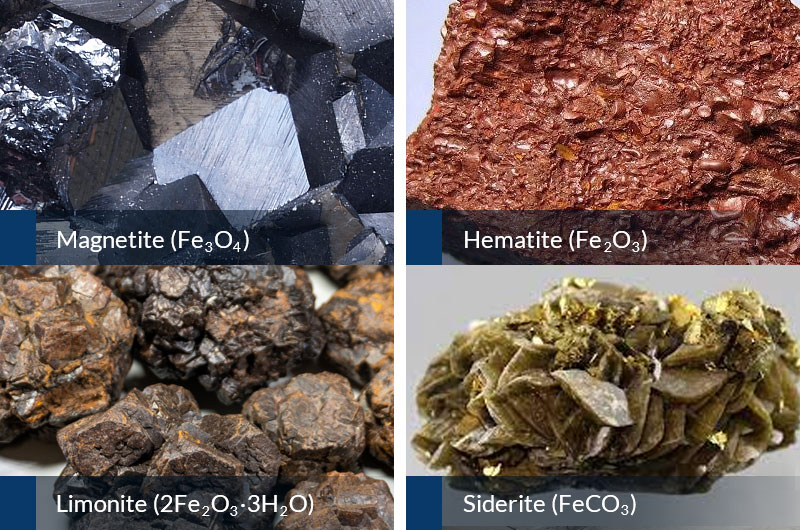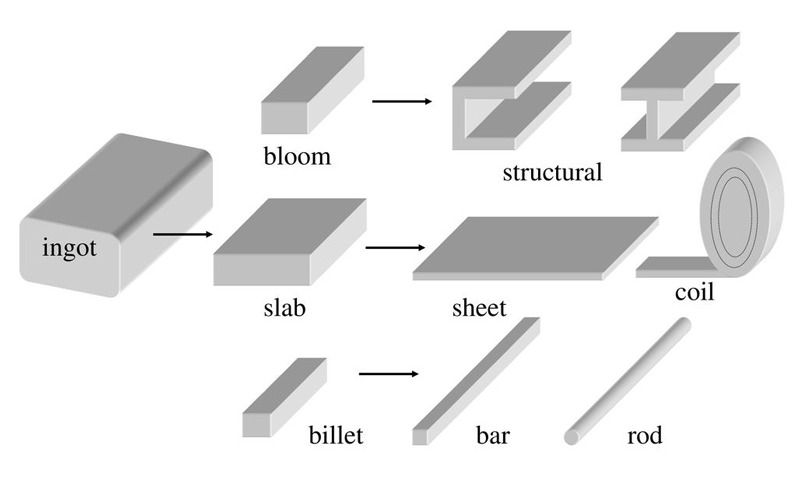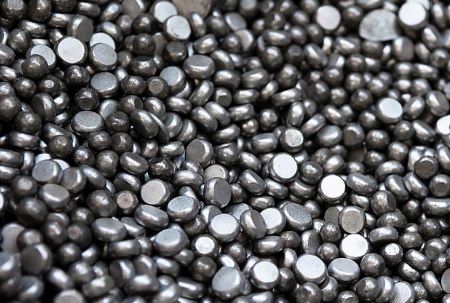Iron ore
Iron ore is one of the most common and widely used types of minerals, which consists of more than 20% of iron, and after mining and processing, it is used as a raw material for steel production in steel factories.
Pellet
Pellet is one of the raw materials used in the production of steel sections, which is made using the powder obtained during the extraction process or crushed iron ore. After crushing, iron ore is used as a concentrate to make pellets.
Steel slab
A slab is a semi-finished steel product with a rectangular cross-section, which after one or more processing steps in rolling mills and sheet manufacturing becomes the final product (steel sheets).
Billet
Billet, which is also known as Shamshal, is considered one of the most widely used middle rolled steel products, which has a width of 15 cm, a circular or square cross-sectional area with an area of 230 cm2.
What is iron ore?
Iron ore is one of the most popular and widely used minerals and one of the most abundant rocks on earth, which makes up about 5% of the earth’s crust. This stone, which actually contains streaks of iron, is extracted from mines and after processing and purification, it is used to produce all kinds of metal structures. In this article, we are going to examine how to extract, process and use it and provide you with explanations. Iron ore is known as the primary material for steel production, and about 98% of the extraction of this material in the world is done for the purpose of steel production. The produced steel metal is also fully recyclable and can be used as raw material for the production of steel products with the same initial quality. This element is easily oxidized and its alloy, which is prepared using various elements, especially nickel and chromium, is used to increase the strength of the building and other things. This mineral is mined in about 50 countries, and Australia and Brazil are the largest exporters of this product and China is the largest importer.

Application of iron ore
As we mentioned, the main use of iron ore is in the production of iron and steel. Steel is also used in the manufacture of machinery, automobile industry, construction, transportation such as railways, locomotives and ships, furniture, etc. Except for the above cases, from powdered iron in the manufacture of certain types of steels, magnets, catalysts, from radioactive iron in pharmaceuticals as a tracer element in biochemistry and metalworking research, from black iron oxide in metalworking, as a pigment in polishing compounds, Making magnetic inks in the electronics industry and red iron is used in printing inks, cosmetics and painting colors.
Extraction of iron from iron ore
To use iron ore, it is necessary to purify it. Extraction of iron from iron ore (rocks that contain more than 20% iron are called iron ore) is carried out by special physical, mechanical and chemical processes, in which the iron oxide rocks are reduced by carbon and free iron element. will be For centuries, charcoal was used for regeneration, but from the beginning of the 19th century, coke replaced charcoal and was used. To produce and purify iron ore, smelting and regeneration process must be done in furnaces. There are different methods to perform this process, but the blast furnace is used as the main method of separating iron from its ore.
Iron ore processing
Due to the low grade of iron ore, their impurity, having harmful compounds and also making it easier to use it in different places, processing operations are carried out. After processing, iron ore is produced in various forms, such as granulated, pellets, lumps and concentrates, and consumers prepare and use this product according to their needs. In the following, we will examine these problems.
Granulated iron ore
Waterless and dry method is used to produce granulated iron ore. This type of mineral cannot be used in the regeneration system due to its low grade, and it is less used due to its low regeneration property.
- Concentrate : Water is used to produce concentrate, and its processing steps include crushing, grinding, enrichment, and dewatering. The concentrate can be used in various uses due to its suitable grade.
- Magnetite: Magnetite is the most common method of using iron ore and hundreds of millions of tons of it are produced and used every year.
- Pellet: Pellet is produced from soft and other additives, it is in the form of a pellet, which is raw at first, then it is cooked and hardened, and for regeneration, it is used in the traditional method of iron production in blast furnace or direct regeneration method.
Billets, as primary products in the production of steel products, Billets have many uses in industries and factories for the production of steel sections. These basic products are considered as the primary material for the production of widely used sections in the construction industry, automobile industry, road construction, piping industry and the manufacture of various metal tools and devices. Due to the various characteristics of billets, they can be used in the production of different products with appropriate strength and mechanical properties. It is a type of surface covering that consists of materials such as wire, metal or plastic. This surface coating is usually used to protect various surfaces such as walls, ceilings, bridges, and also to decorate and beautify these surfaces. Billet or billet is used as a raw material for the production of other steel products This product is obtained in steelmaking units through the process of melting and casting from raw materials such as sponge iron along with other additives. Billets are produced in the form of large pieces with standard dimensions and are used in the manufacture of other steel products during various processes. They are produced in different sizes and shapes and can be easily installed. Also, Billets are resistant to weather conditions and various impacts and are used as a simple and economical solution to preserve and decorate surfaces.

- A billet or shamshal is a type of ingot with a square, circular or octagonal cross-section, whose cross-sectional area is at least 25 and at most 225 square centimeters. These ingots are produced in both casting and rolling forms and are directly used in the production of bars, wires or wires.
- Slab is a type of steel ingot with a rectangular cross-section, the cross-sectional area of which is at least 100 square centimeters, and it is produced by casting and rolling. These ingots have a thickness of over 160 mm and are produced through the continuous casting method. The final products include all kinds of sheets, plates, strips, belts and sub-sheets.

What are the uses of billets?
Steel billet has various applications in the industry. Billets can be used to make all kinds of steel sections other than sheets. The most common billet product is rebar, which is widely used in civil and construction projects. In addition to rebar, billet is also used in bridge, rail and extrusion industries.
Billet is also used in bridge building, railway and extrusion industries. Beam, wire, simple and ribbed rebar, corner, stud, shield, seamless pipes and
Shamshal is one of the most important elements of beautification and construction, which is used in its construction and installation in various buildings. Unlike in the old days, today shamshals are produced industrially and can be produced in different designs and using different materials.
- Use in steel industry to produce black sheet, pipe and various profiles
- Used in the construction industry to produce braces and structural parts
- Use in the automotive industry to produce car parts

Applications for pellet
Pellet is one of the most widely used raw materials in the blast furnace and is used in the production of steel products by the direct regeneration method. Because the components used in pellet production increase the degree of porosity, contact surface and solid contact and increase the regenerability of iron.
pellet production
Pelletization process is a combination of raw material mixing, pellet formation and heat treatment of baking and turning it into hard spheres. The raw material is rolled into a ball, then fired in a furnace or griddle to sinter the particles into a hard sphere. Configuring the iron ore pellets as packed spheres in the blast furnace allows air to flow between the pellets, reducing the resistance to air flowing up through the layers of material during melting. The configuration of iron ore powder in the blast furnace is more compact and restricts the air flow This is why iron ore in pellets is preferred over finer particles. The quality of iron ore pellets depends on various factors, including the size of the particles, the amount of water used, and the speed of the disc rotation. It depends on the angle of inclination of the bottom of the disk, the time it stays in the disk, as well as the quality and quantity of the adhesive(s) used. Soft iron ore with dimensions of 45 microns along with water and other additives such as lime, calcium hydroxide, bentonite and various organic and inorganic adhesives are combined with a specific ratio in the pelletizing machine to make pellets. Pellet analysis includes metal oxides such as manganese, calcium, titanium, aluminum, magnesium, silicon, vanadium, sulfur and phosphorus.
